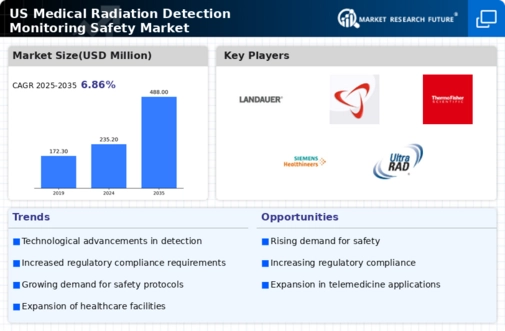Rising Incidence of Chronic Diseases
The increasing prevalence of chronic diseases in the US, such as cancer and cardiovascular conditions, drives the demand for advanced medical radiation-detection-monitoring-safety market solutions. As healthcare providers seek to enhance diagnostic accuracy and treatment efficacy, the need for reliable radiation detection and monitoring systems becomes paramount. According to the National Cancer Institute, approximately 1.9 million new cancer cases are expected in 2025, necessitating improved safety measures in radiation therapy. This trend indicates a growing market for devices that ensure patient and staff safety during radiation procedures, thereby propelling the medical radiation-detection-monitoring-safety market forward.
Growing Awareness of Radiation Safety
There is a notable increase in public and professional awareness regarding the risks associated with radiation exposure, which is influencing the medical radiation-detection-monitoring-safety market. Educational campaigns and professional training programs emphasize the importance of radiation safety protocols in medical settings. As healthcare professionals become more informed about the potential hazards, the demand for effective radiation detection and monitoring solutions rises. This heightened awareness is likely to lead to a more stringent regulatory environment, further driving the need for advanced safety technologies in the medical radiation-detection-monitoring-safety market.
Technological Integration in Healthcare
The integration of cutting-edge technologies, such as artificial intelligence and machine learning, into healthcare systems is transforming the medical radiation-detection-monitoring-safety market. These technologies enhance the precision of radiation detection and monitoring, allowing for real-time data analysis and improved decision-making. For instance, AI algorithms can predict potential radiation exposure risks, thereby optimizing safety protocols. The market for AI in healthcare is projected to reach $45 billion by 2026, indicating a substantial opportunity for innovation in radiation safety solutions. This technological evolution is likely to drive the demand for advanced monitoring systems in the medical radiation-detection-monitoring-safety market.
Increased Government Funding for Healthcare
Government initiatives aimed at improving healthcare infrastructure in the US are significantly impacting the medical radiation-detection-monitoring-safety market. Increased funding for healthcare facilities, particularly in underserved areas, facilitates the acquisition of advanced radiation detection and monitoring equipment. The US government allocated approximately $1.5 billion in 2025 for healthcare technology upgrades, which includes radiation safety measures. This financial support is expected to enhance the capabilities of medical institutions, thereby fostering growth in the medical radiation-detection-monitoring-safety market as facilities invest in state-of-the-art safety technologies.
Emerging Market for Home Healthcare Solutions
The shift towards home healthcare solutions is reshaping the medical radiation-detection-monitoring-safety market. As more patients receive treatments at home, the need for portable and user-friendly radiation detection devices increases. This trend is particularly relevant for patients undergoing radiation therapy, as home monitoring ensures safety and compliance with treatment protocols. The home healthcare market is projected to grow at a CAGR of 8% through 2027, indicating a significant opportunity for manufacturers of radiation safety devices. This evolution in patient care is likely to drive innovation and demand within the medical radiation-detection-monitoring-safety market.
















Leave a Comment